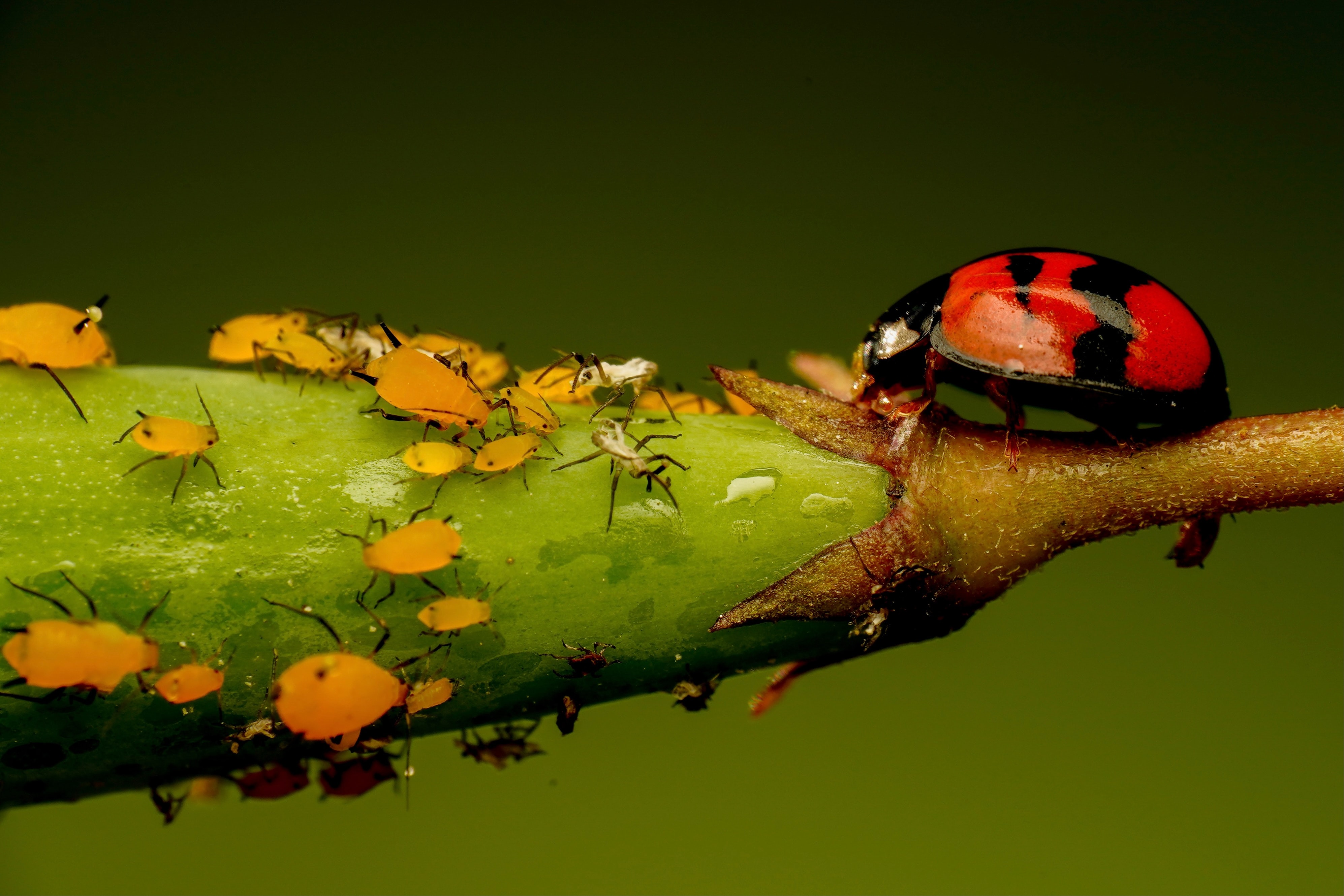How to get rid of aphids – don’t let plants succumb to these minuscule destroyers
The enemy of gardeners? Aphids. Find out how to get rid of them with our comprehensive guide


Aphids are tiny bugs that make for unwelcome visitors in many a garden. As soon as the weather warms up, there they are, sucking the sap from plants, making the leaves curl and inviting black mold.
Annoyingly, aphids seem to hone in on new growth when plants are just getting going. Some types prefer to carry on their work unseen, making their home in the soil and roots of plants.
Our guide has the details on identifying and banishing aphids so you can stop them compromising your garden ideas.
How can I recognize aphids?
These tiny pear-shaped creatures, just ¼in or less (1 to 7mm) would be easy to miss, except for their tendency to cluster in their hundreds on stems or the underside of leaves. You might also spot raised growths on the top of leaves. Aphids cause a plant to form these galls, which they live in.
Aphids come in various guises. As well as the common greenfly and blackfly, there are yellow, orange, brown and pink relations, as well as a woolly beech aphid which disguises itself with a waxy white secretion. Most aphids don’t fly but a few develop wings in order to travel and seek out new homes.
What do aphids do to plants?
You’ll want to banish aphids along with getting rid of snails and getting rid of slugs because of what they do to your plants. There’s nothing an aphid likes better than a plant with succulent sap to suck on. This can result in plants growing weakly, with distorted stems and leaves. Many aphids leave a sticky honeydew coating that encourages black mold. Ants are fond of the honeydew and will ‘farm’ aphids in order to get it, protecting them against predators. Some aphids can transmit plant viruses.
Keep an eye on plants that aphids love to feast on as soon as spring starts.
How to get rid of aphids
Always start with a non-pesticidal control for any pest in your garden. Only if you cannot control an invasion and it begins to get out of hand should you consider pesticides which can do harm to beneficial insects, other plants, your soil, pets and even humans. And, of course, organic pesticides are a better option if you do resort to them.
The best way to begin aphid control is by hand. As soon as you spot aphids on leaves and stems, squish them between your finger and thumb.
A good spurt of water from the garden hose will knock them for six. This method is too damaging for the delicate plants you’ve been nurturing but can be a game changer for larger shrubs and trees.
Out of season – in winter – look out for aphid eggs on fruit trees and shrubs, removing them with a plant oil winter wash. Choose a frost-free, dry day to do this – if done thoroughly, you may not need to resort to spring aphid control at all.
Spray aphids with soapy water
Wiping leaves and stems with soapy water or spritzing them from a spray bottle is a natural method, though use pure Castile liquid soap since it does not have the additives that dish detergent and other soaps and detergents contain. Make a test run on a few leaves first to check that no damage is caused.
Dust aphids with diatomaceous earth
Diatomaceous earth sprinkled onto aphids will pierce their outer casing, so that they simply dry out. Although the earth is a non-chemical treatment made from fossilized algae, use it sparingly since it can harm other insects and pollinators that the garden relies on. Avoid applying it when plants are blooming.
Encourage the enemies of aphids into the garden
Aphids' natural enemies include ladybirds, hoverflies, ground beetles, earwigs and parasitoid wasps. These can be encouraged into the garden with clever planting – put what they like into flowerbeds and they will go to work.
To deal with an infestation of troublesome aphids in the greenhouse, put a parasite to work. Tiny creatures supplied in small tubes – hoverfly larvae, for example – will hatch, fly out and lay an egg in the aphid which will hatch and destroy it. Look for 'aphid control' locally for these.
Spray aphids with a natural, home-made pesticide
Neem oil, which comes from the Azadirachta indica tree, is a natural insecticide that can help in the fight against an aphid infestation. Make a solution from a quart of water, one teaspoon of neem oil and a third of a teaspoon of mild liquid or insecticidal soap. Shake it up and spray affected plants.
Try it out on a few leaves first, and avoid applying when the sun is out since the oil could burn the leaves. If you’re using it on fruit or veg, wash them thoroughly before eating. And do keep it well away from pets.
Bear in mind that this type of pesticide often have 'short persistence' which means it will need reapplying.
Kill aphids with a pesticide – as a last resort
A natural treatment against aphids is best for the environment. If you must use a pesticide, select an organic one. Sprays containing natural pyrethrum, fatty acids, or plant oils should hold them back, but you’ll need repeat applications.
Be aware that pesticides may also kill other friendly insects, such as bees that you’d prefer to have a home in your garden. Follow the pack instructions carefully and keep these products well away from children and pets.
To deter aphids further, organic fumigants can be used in glasshouses. Fruit trees and shrubs can be given a plant oil winter wash to control aphid eggs.
See Amazon's wide range of organic aphid controls on their dedicated page.
How to get rid of root aphids
To get rid of root aphids, first identify the problem. If plants have stunted growth, unhealthy foliage and lose their leaves, root aphids could be the cause. You might spot a waxy mould or powder rather than the aphids themselves.
Expect to see ants around the plants, feeding on the honeydew aphids secrete. The roots will often split. There are root aphids specific to particular fruits, vegetables and plants.
Regular watering will help to wash them away, and young pot plants can be repotted in fresh soil. Try covering young lettuce and other plants with an insect-proof mesh from June until August to keep the aphids at bay. Clear away affected plant material and avoid growing similar plants in that patch of soil for a year.
Deter aphids with clever planting
If you have plants that are susceptible to aphids, say a firm ‘no’ by planting strong scented alliums such as onions or garlic close by to protect them.
Another preventative measure is to grow plants that aphids love such as nasturtiums, mustard and cosmos to encourage them to settle there, rather than on prize blooms.
Marigolds, fennel and Michaelmas daisies will attract ladybugs and hoverflies, which love to feast on aphids.
Sign up to the Homes & Gardens newsletter
Design expertise in your inbox – from inspiring decorating ideas and beautiful celebrity homes to practical gardening advice and shopping round-ups.

Lola Houlton is a news writer for Homes & Gardens. She has been writing content for Future PLC for the past six years, in particular Homes & Gardens, Real Homes and GardeningEtc. She writes on a broad range of subjects, including practical household advice, recipe articles, and product reviews, working closely with experts in their fields to cover everything from heating to home organization through to house plants. Lola is a graduate, who completed her degree in Psychology at the University of Sussex. She has also spent some time working at the BBC.
-
 The 11 British interior design styles you are going to want to bring into your home – no matter which side of the pond you live on
The 11 British interior design styles you are going to want to bring into your home – no matter which side of the pond you live onInterior designers share their favorite British design trends and how to recreate them in your own home
By Pippa Blenkinsop Published
-
 7 ways to decorate with wood – designers share the best ways to make the most out of this versatile material
7 ways to decorate with wood – designers share the best ways to make the most out of this versatile materialThis is how the design experts embrace the timeless natural beauty of decorating with wood
By Karen Darlow Published